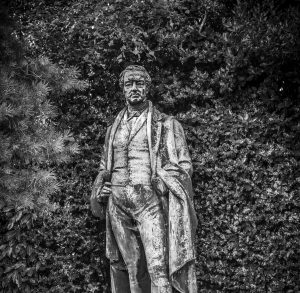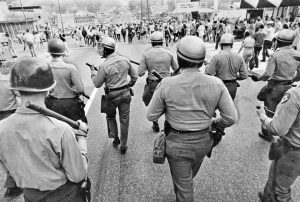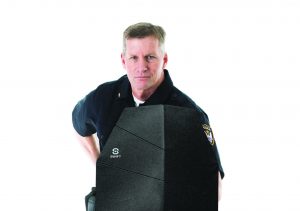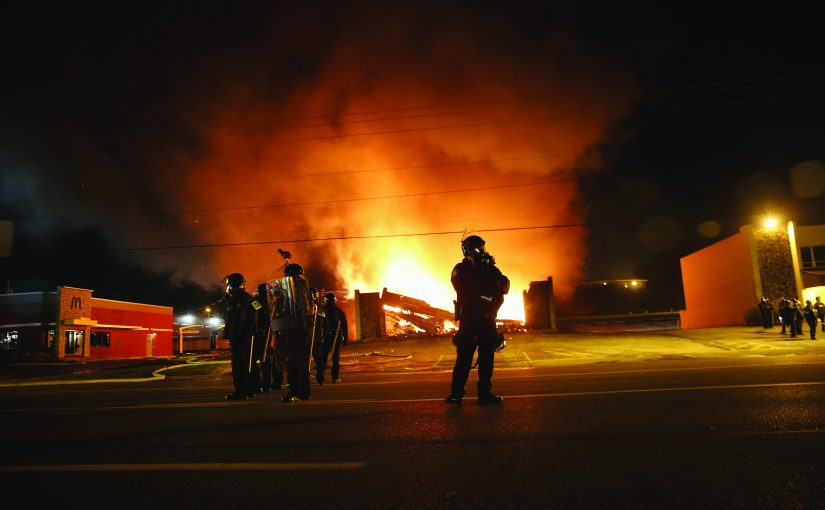In 2020, the policing profession in the United States faced the daunting task of balancing public safety with preserving citizens’ rights to assemble and voice their concerns. The dynamic nature of the protests during that tumultuous year, often fueled by emotions and amplified through social media, posed difficulties to the police’s ability to anticipate and respond to emerging situations. Instances of perceived or real police misconduct further strained community trust and heightened tensions. These events underscored the need for the police to adapt their crowd management strategies, emphasizing de-escalation, open communication, and a deeper understanding of the diverse motivations behind public demonstrations. The challenges of 2020 should serve as a catalyst for reevaluation and reform within the realm of public order policing in the United States.

Sir Robert Peel formulated nine principles in the 1800s, which serve as the foundation of modern-day policing. One of these principles states that the police and the public are indistinguishable. Peel believed that the effectiveness of the police should not be measured by visible actions but by the absence of crime and disorder. His second principle established that the police’s authority depended on public support of their behavior, actions, and existence.1 These two principles serve as the basis for public order policing. Public order policing relies on trust between the community and the police force, built on reliable, professional, and unbiased policing. It requires a delicate balance between protecting individual rights and ensuring the community’s welfare while preventing and managing civil disturbances. This field calls for officers with specialized training in crowd control, conflict resolution, and strategic planning to effectively navigate and mitigate possible disruptions while upholding the principles of a fair and democratic society.
An effective public order policing program hinges on several key elements, each crucial in maintaining peace while respecting individual rights. First and foremost, communication and de-escalation skills are essential for diffusing tensions and fostering a constructive dialogue between the police and the public. Evidence-based training equips officers with the latest and most effective techniques grounded in empirical research, ensuring their preparedness for dynamic crowd scenarios.2 Proportionate uses of force are imperative, emphasizing the necessity of calibrated responses tailored to the threat level, thereby mitigating the risk of excessive force allegations. Finally, proper protective equipment is indispensable for the safety of both officers and the community. Integrating these elements creates a comprehensive approach that prioritizes public safety, upholds constitutional rights, and contributes to positive community-police relations.
Dialogue Policing
The recent increase in demonstrations and protests throughout the United States has emphasized the need to protect First Amendment activities. An emerging approach, inspired by research conducted by Dr. Clifford Stott, Keele University, Staffordshire, UK, on the empathy transformation model, is gaining traction as a strategy for ensuring security while upholding these fundamental rights.3 This concept of dialogue policing has shown significant potential in promoting constructive interaction among activists, communities, and socio-democratic groups. This is exemplified by the establishment of a Dialogue Team within the Columbus, Ohio, Police Department following protests in 2022.
The Columbus Police Department Dialogue Team comprises officers who connect with the community to engage in open and unbiased dialogue. Dialogue policing is centered on communication and engagement with the public to manage social conflicts and effectively maintain order. It prioritizes establishing trust between police officers and community members through open communication channels, cooperation, and mutual understanding. Ultimately, this approach aims to mitigate tension, prevent escalation of conflicts, and enhance relations between police personnel and the public. Dialogue is most effective when communication channels are open before, during, and after events.
Effective communication is critical in crowd management situations. Police officers must communicate clearly and effectively with the crowd to prevent misunderstandings and de-escalate tensions. However, current training programs often do not place enough emphasis on communication skills. As a result, officers may not be adequately prepared to handle situations where communication is critical. Ineffective communication can lead to confusion, misinterpretation, and a lack of cooperation from the crowd, which can further escalate the situation. Therefore, police agencies must prioritize communication skills in their training programs to ensure officers can handle crowd situations effectively and safely. Police commanders and leaders must know when and how to use protective tactics appropriately to assure the safety of officers and the public.
Training and Education
Current crowd management training for police professionals has shortcomings that need to be addressed to ensure the safety of officers and the public. There have been no national standards for selecting public order officers or for providing training, equipment, tactics, or command in the United States. To provide a benchmark for performance and operations in June 2023, the National Tactical Officers Association released its Public Order Response and Operational Standards.4 These standards cover techniques for managing crowds, strategies for de-escalation, methods for dispersing crowds, and the appropriate use of nonlethal force. However, due to the lack of specific U.S. nationwide standards, police agencies have developed city-specific models and rely on equipment capabilities to derive tactics and acquire equipment. This lack of standardized training can limit an adaptive and situationally informed approach to policing these events.
The importance of evidence-based training in public order policing cannot be overstated, as it forms the cornerstone for effective and responsible policing. In an era of heightened public scrutiny, relying on empirically supported training methods ensures officers have the most efficient tools and strategies for managing crowds and demonstrations. Evidence-based training fosters the development of skills grounded in research and real-world scenarios, enhancing the ability of police professionals to navigate complex situations while minimizing the risk of excessive force. By incorporating data-driven insights into training curricula, agencies can continually adapt and improve their approaches, ultimately promoting the safety of their officers and the communities they serve.
 After the protests of the 1960s, there were inquiries into the police handling of the events. Police officers were taught to assist First Amendment events by communicating with groups and organizations ahead of time, according to the new model. However, in the 1990s, training and response swung in the opposite direction, resulting in violent confrontations between police and protesters. The Mobile Field Force Model was employed for protests at the Republican National Convention in Philadelphia, Pennsylvania, and the Free Trade Area of the Americas negotiations in Miami, Florida, during the 2000s.5 Following the Free Trade Area of the Americas, more than 20 protesters sued the city of Miami, and the city and county paid $460,000.00 in a settlement.6 Many such techniques and tactics have exacerbated the conflicts between the police and communities throughout history.
After the protests of the 1960s, there were inquiries into the police handling of the events. Police officers were taught to assist First Amendment events by communicating with groups and organizations ahead of time, according to the new model. However, in the 1990s, training and response swung in the opposite direction, resulting in violent confrontations between police and protesters. The Mobile Field Force Model was employed for protests at the Republican National Convention in Philadelphia, Pennsylvania, and the Free Trade Area of the Americas negotiations in Miami, Florida, during the 2000s.5 Following the Free Trade Area of the Americas, more than 20 protesters sued the city of Miami, and the city and county paid $460,000.00 in a settlement.6 Many such techniques and tactics have exacerbated the conflicts between the police and communities throughout history.
One of the significant problems with current crowd management training is the lack of focus on de-escalation techniques. Police officers are often trained to use force to control crowds, but this approach can escalate the situation and lead to violence. On the other hand, de-escalation techniques can help calm the crowd and prevent violence from breaking out. Unfortunately, many police officers are not trained in these techniques, which can lead to unnecessary violence and injuries. Moreover, excessive force can lead to mistrust and hostility toward the police, particularly among minority communities.7
Police officers who maintain public order have distinct responsibilities and require a comprehensive training program to develop the necessary skills to carry out their duties effectively. Often, the public order training programs offered to police personnel are inadequate, as they tend to be too brief and not thorough. This insufficiency in training programs can lead to responses that erode communities’ trust in the police, leading to catastrophic outcomes. It is essential to understand that the issue of inadequate police training is not limited to individual departments or jurisdictions but rather a systemic issue that necessitates a collective effort to address. Police agencies need to seek out or develop evidence-based training. Training based on evidence for public order policing plays a significant role in enhancing the safety of officers and reducing the likelihood of injuries to officers and civilians. With sufficient knowledge and skills to handle crowds and manage potentially dangerous situations, evidence-based training can effectively prevent violence and minimize the use of force.
Force Considerations
In situations of civil disorder, the use of force by police agencies is a highly sensitive and complex issue. The proportional use of force is crucial in maintaining order and ensuring the safety of both the public and police officers. Unless exigent circumstances justify immediate action, officers shall not independently make arrests or employ force without command authorization. If force is required, the incident commander or designee should order the use of force. Even then, every officer must use as little force and cause as little injury to a person and property as possible.
Evidence-based training fosters the development of skills grounded in research and real-world scenarios, enhancing the ability of police professionals to navigate complex situations while minimizing the risk of excessive force.
Hand-thrown munitions (e.g., flash bang, tear gas) are a standard fallback option for dispersing most demonstrations that have turned into a state of disorder. It is crucial to consider that these devices can potentially cause harm to innocent individuals and those who have committed offenses. Thus, it is necessary to implement measures that mitigate this risk and prioritize the safety and well-being of all community members. It is essential to consider the broader impact of these devices and take a proactive approach to address any potential negative consequences. Ensuring that these devices are used responsibly and justly is paramount to maintaining a safe and equitable environment for all individuals.
Moreover, it can also cost an agency or city financially due to decontamination and civil lawsuits. Some agencies worldwide have moved away from this type of munition. Some of the modern less-than-lethal weapon systems available to the police for crowd control in violent situations can be highly effective. However, proficiency through training is essential, and such weapon systems need to be highly accurate and used only against individuals committing violent offenses whom officers intend to arrest.
It is vital to strike a balance between maintaining public order and respecting the rights of individuals. Police officers are responsible for exercising restraint and limiting the use of force when necessary to protect themselves or others from harm. Implementing de-escalation techniques and nonlethal methods should be prioritized to minimize the risk of unnecessary harm or injury. Additionally, accountability measures must be in place to ensure that any use of force is thoroughly reviewed and justified. By prioritizing de-escalation and accountability measures, police agencies can work toward building trust with the community and ensuring the safety of all individuals involved.
Personal Protective Equipment
Police agencies engaged in public order policing should facilitate the lawful expression of legal and/or constitutionally protected assembly and free speech. However, protective tactics may be necessary to maintain order. In case of any disorder, police officers must be trained in the appropriate tactics and have the needed personal protective equipment to reduce the risk of injuries to officers and civilians, allowing officers to respond to evolving situations with composure and to make better critical decisions.8

In recent years, there has been a notable rise in the dangers presented by violent individuals and groups toward police officers tasked with handling public order events. In the summer of 2020, U.S. police officers encountered blunt trauma injuries and lacerations inflicted by various weapons like baseball bats, bottles, ball bearings, and bricks. They also faced thermal injuries from Molotov cocktails, improvised explosive devices, commercial-grade fireworks, mortars, and other incendiary substances.9 Additionally, they endured skin, eye, and respiratory injuries due to exposure to makeshift chemical weapons, along with temporary visual impairment caused by lasers. Public order personal protective gear is specifically engineered and evaluated to operate as a unified system for officer safety. This comprehensive ensemble must enable officers to move freely and execute defensive strategies when confronted with disorderly situations. To guarantee the seamless functionality of this protective gear, adherence to performance and evaluation criteria for impact resistance, liquid protection capabilities, and flame-retardant properties is imperative. The essential gear for a public order officer comprises a helmet equipped with a visor; authorized respiratory gear; and protective wear for the head, chest, shoulders, abdomen, arms, and groin area. The gloves should be cut-resistant and flame-retardant, while the footwear needs to ensure metatarsal protection; be resistant to flames, chemicals, and liquids; and have antistatic soles. Additionally required are outer garments that protect the wearer from flames, chemicals, and biohazards.
Police personnel must possess a knowledge of personal protective equipment and other safety gear to equip themselves adequately. The effective use of protective gear can lower officers’ chances of injury and illness, shield them from exposure to dangerous substances, and guarantee their safety while on duty. Negligent actions and haphazard utilization of force can lead to severe repercussions. Studies have indicated that proper training and the appropriate gear can enhance officer effectiveness, reduce the use of force, and enhance critical decision-making in high-pressure situations.10
Conclusion
Due to the evolving dynamics of societal engagement and increased public expectations, the police profession needs to reevaluate its approach to crowd management. Traditional tactics that rely heavily on force may exacerbate tensions and erode trust between police agencies and communities. Embracing more community-oriented strategies, including de-escalation tactics, is crucial to fostering a positive relationship with the public prior to and during large gatherings or protests. Rethinking crowd management involves embracing transparency and communication and understanding the diverse motivations behind public demonstrations. By employing methods that prioritize dialogue and respect for constitutional rights, the police can adapt to a changing social landscape, enhance community relationships, and ensure the safety and well-being of both officers and the public.
Ensuring public order is a complex undertaking for U.S. law enforcement. On the one hand, safeguarding citizens’ First Amendment rights to peaceful assembly is crucial, but on the other hand, maintaining order and preventing potential disturbances are equally essential. Managing large-scale events, protests, or demonstrations involves meticulous planning and allocation of resources, which can be difficult for police agencies with limited resources. The constantly evolving nature of protests, fueled by the rapid spread of information through social media, further complicates the police’s ability to anticipate and effectively manage crowd behavior. Striking a balance between officer and public safety and constitutional rights is a continuous challenge for U.S. police agencies engaged in public order policing. 🛡
Notes:
1Law Enforcement Action Partnership, “Sir Robert Peel’s Policing Principles.”
2Jason J. Kepp, “Building an Evidence-Based Training Curriculum for Public Order Policing: A Case Study,” in Public Order Policing: A Professional’s Guide to International Theories, Case Studies, and Best Practices, eds. Bernd Bürfer, Tamara D. Herold, and Ryan Lee (Cham, Switzerland: Springer Nature Switzerland, 2023), 449–464.
3Hugo Gorringe, Clifford Stott, and Michael Rosie, “Dialogue Police, Decision Making, and the Management of Public Order During Protest Crowd Events,” Journal of Investigative Psychology and Offender Profiling 9, no. 2 (June 2012): 111–125.
4Spencer Fomby, “Public Order Policing: Use of Force,” in Public Order Policing: A Professional’s Guide to International Theories, Case Studies, and Best Practices, eds. Bernd Bürfer, Tamara D. Herold, and Ryan Lee (Cham, Switzerland: Springer Nature Switzerland, 2023), 465–486.
5Kepp, “Building an Evidence-Based Training Curriculum for Public Order Policing: A Case Study.”
6Kepp, “Building an Evidence-Based Training Curriculum for Public Order Policing: A Case Study.”
7Brian Kingshott, “Police Behavior in Crowd Situations – A Recipe for Violence?” Police Journal 66, no. 4 (October–December 1993): 366–376.
8Jason J. Kepp, “Considerations for Personal Protective Equipment for Public Order Policing,” in Public Order Policing: A Professional’s Guide to International Theories, Case Studies, and Best Practices, eds. Bernd Bürfer, Tamara D. Herold, and Ryan Lee (Cham, Switzerland: Springer Nature Switzerland, 2023), 487–503.
9Kepp, “Considerations for Personal Protective Equipment for Public Order Policing.”
10Simon Baldwin et al. “A Reasonable Officer: Examining the Relationships Among Stress, Training, and Performance in a Highly Realistic Lethal Force Scenario,” Frontiers in Psychology 12 (2022).
Please cite as
Jason J. Kepp, “Public Order Policing: A Primer for the Way Forward,” Police Chief Online, June 12, 2024.



